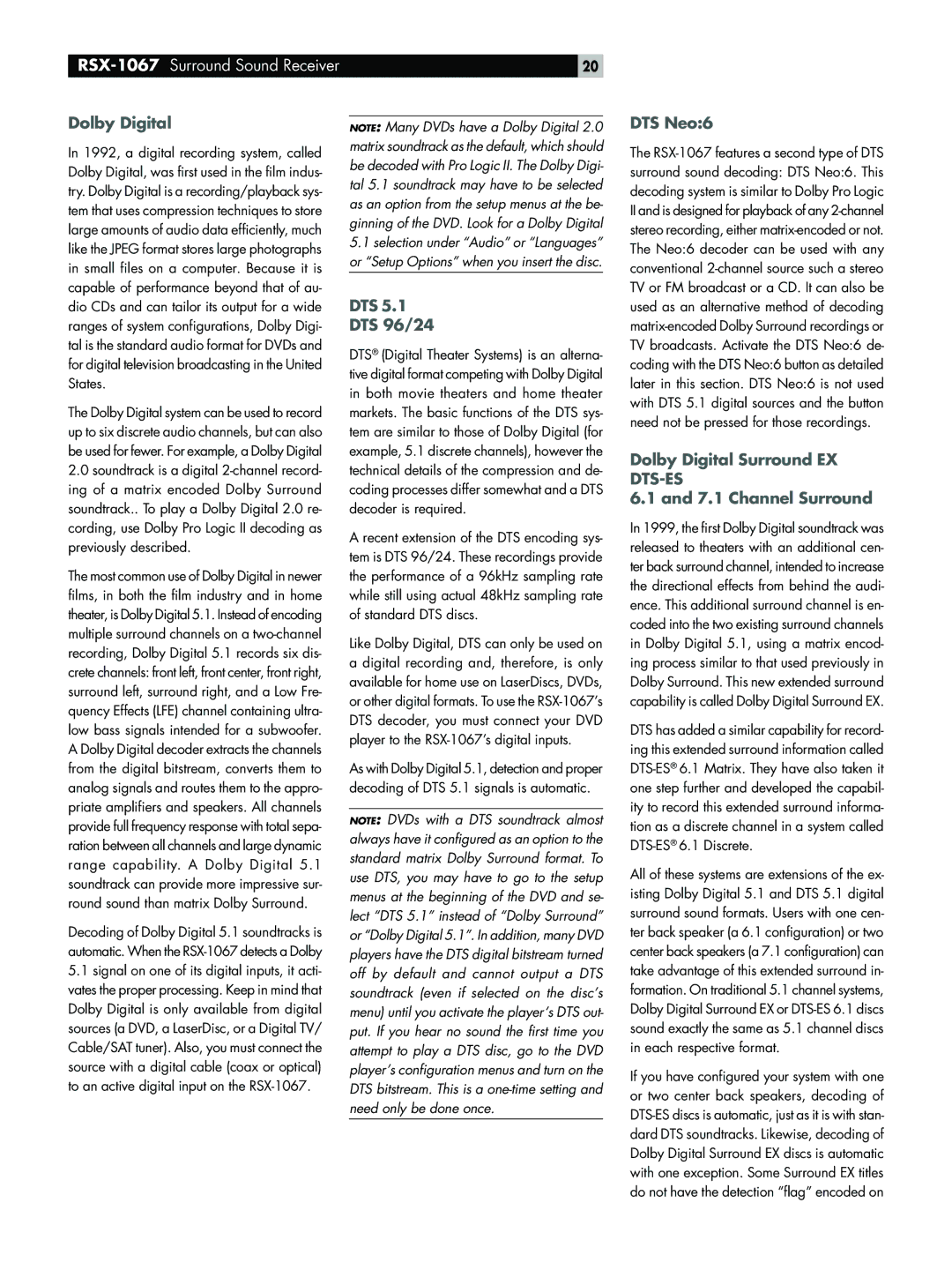
| 20 |
Dolby Digital
In 1992, a digital recording system, called Dolby Digital, was first used in the film indus- try. Dolby Digital is a recording/playback sys- tem that uses compression techniques to store large amounts of audio data efficiently, much like the JPEG format stores large photographs in small files on a computer. Because it is capable of performance beyond that of au- dio CDs and can tailor its output for a wide ranges of system configurations, Dolby Digi- tal is the standard audio format for DVDs and for digital television broadcasting in the United States.
The Dolby Digital system can be used to record up to six discrete audio channels, but can also be used for fewer. For example, a Dolby Digital
2.0soundtrack is a digital
The most common use of Dolby Digital in newer films, in both the film industry and in home theater, is Dolby Digital 5.1. Instead of encoding multiple surround channels on a
Decoding of Dolby Digital 5.1 soundtracks is automatic. When the
5.1signal on one of its digital inputs, it acti- vates the proper processing. Keep in mind that Dolby Digital is only available from digital sources (a DVD, a LaserDisc, or a Digital TV/ Cable/SAT tuner). Also, you must connect the source with a digital cable (coax or optical) to an active digital input on the
NOTE: Many DVDs have a Dolby Digital 2.0 matrix soundtrack as the default, which should be decoded with Pro Logic II. The Dolby Digi- tal 5.1 soundtrack may have to be selected as an option from the setup menus at the be- ginning of the DVD. Look for a Dolby Digital
5.1selection under “Audio” or “Languages” or “Setup Options” when you insert the disc.
DTS 5.1
DTS 96/24
DTS® (Digital Theater Systems) is an alterna- tive digital format competing with Dolby Digital in both movie theaters and home theater markets. The basic functions of the DTS sys- tem are similar to those of Dolby Digital (for example, 5.1 discrete channels), however the technical details of the compression and de- coding processes differ somewhat and a DTS decoder is required.
A recent extension of the DTS encoding sys- tem is DTS 96/24. These recordings provide the performance of a 96kHz sampling rate while still using actual 48kHz sampling rate of standard DTS discs.
Like Dolby Digital, DTS can only be used on a digital recording and, therefore, is only available for home use on LaserDiscs, DVDs, or other digital formats. To use the
As with Dolby Digital 5.1, detection and proper decoding of DTS 5.1 signals is automatic.
NOTE: DVDs with a DTS soundtrack almost always have it configured as an option to the standard matrix Dolby Surround format. To use DTS, you may have to go to the setup menus at the beginning of the DVD and se- lect “DTS 5.1” instead of “Dolby Surround” or “Dolby Digital 5.1”. In addition, many DVD players have the DTS digital bitstream turned off by default and cannot output a DTS soundtrack (even if selected on the disc’s menu) until you activate the player’s DTS out- put. If you hear no sound the first time you attempt to play a DTS disc, go to the DVD player’s configuration menus and turn on the DTS bitstream. This is a
DTS Neo:6
The
IIand is designed for playback of any
Dolby Digital Surround EX
DTS-ES
6.1 and 7.1 Channel Surround
In 1999, the first Dolby Digital soundtrack was released to theaters with an additional cen- ter back surround channel, intended to increase the directional effects from behind the audi- ence. This additional surround channel is en- coded into the two existing surround channels in Dolby Digital 5.1, using a matrix encod- ing process similar to that used previously in Dolby Surround. This new extended surround capability is called Dolby Digital Surround EX.
DTS has added a similar capability for record- ing this extended surround information called
All of these systems are extensions of the ex- isting Dolby Digital 5.1 and DTS 5.1 digital surround sound formats. Users with one cen- ter back speaker (a 6.1 configuration) or two center back speakers (a 7.1 configuration) can take advantage of this extended surround in- formation. On traditional 5.1 channel systems, Dolby Digital Surround EX or
If you have configured your system with one or two center back speakers, decoding of
